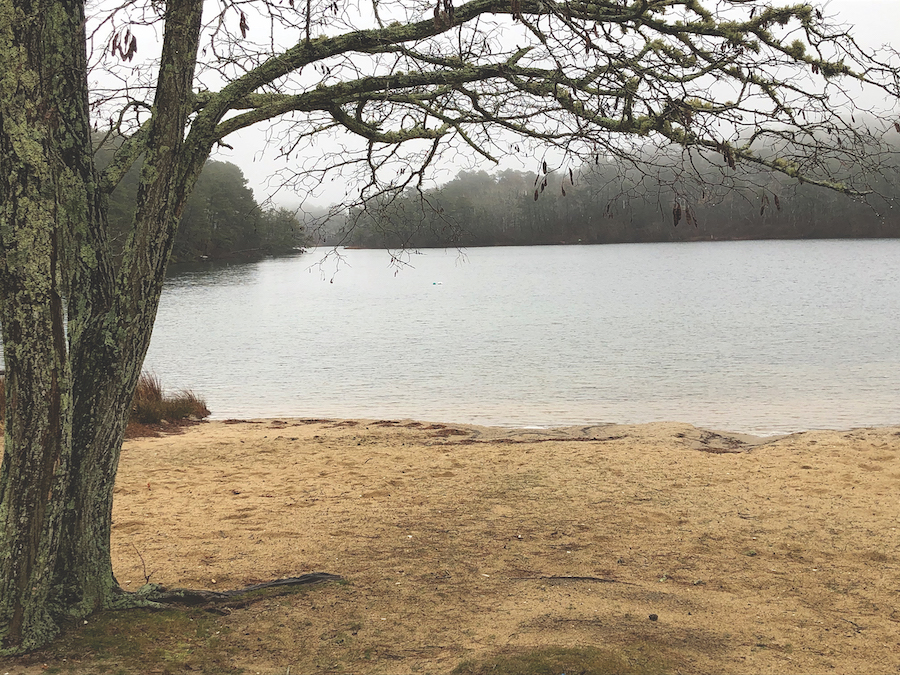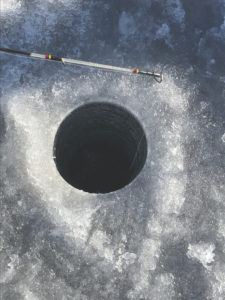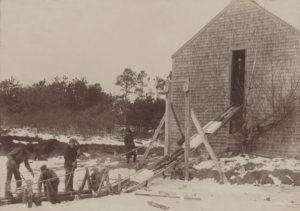WELLFLEET — Jake McGrath of Eastham counts the number of days when the temperature stays below freezing. He’s not counting down to summer. He’s hoping it will stay cold enough for the kettle ponds to freeze over.
McGrath, 24, grew up ice fishing with his father on Outer Cape ponds. It’s a family tradition that McGrath’s dad learned from his grandfather.

But the long cold snaps required for the ponds to freeze — at least three days under 32 degrees — have yet to arrive this winter, and thick ice is nowhere to be found.
Although one mild winter doesn’t necessarily point to a warming world, this is not a story about one winter. Scientific studies have documented rising air and water temperatures on Cape Cod over the past few decades. From 1988 to 2013, the surface water of ponds in Truro and Wellfleet warmed by an average of 1.9 degrees Celsius (3.4 degrees F) as measured in July. Long Pond in Wellfleet has warmed even more: 2.4 degrees C, or 4.3 degrees F. Those numbers are from a recent study coauthored by National Seashore ecologist Stephen Smith.
Although the Seashore does not collect data throughout the winter on kettle pond temperatures or ice, Smith told the Independent that other studies have confirmed that ponds are freezing less frequently, and ice is melting earlier in the spring.

“There’s tons of research using long-term monitoring data that shows throughout New England the last date of pond ice,” Smith said. “It’s become earlier and earlier throughout the years.” And there’s no end in sight: “We expect to see ponds continue to warm up throughout the winter.”
Faced with this contemporary reality, it’s hard to imagine that just 150 years ago, in the late 1800s, businesses depended on kettle pond ice. The workers at ice houses on Wellfleet’s Long Pond and on Shank Painter Pond in Provincetown used saws to harvest ice, which could grow 8 to 12 inches thick in cold winters. The ice was then stored in insulated barns, to be sold for ice boxes in the hot summer months.
Remembering Hockey
McGrath remembers, not many years ago, crowds of people enjoying frozen kettle ponds in Nickerson State Park and in Eastham. When the ice layer grew greater than three inches, fishermen would start walking out along the edges, testing the surrounding ice to make sure it was thick enough to hold them.
Ice fishing is different from shore fishing, McGrath explained. Fishermen can access parts of ponds that would otherwise be inaccessible from the shore, planting themselves over holes at the deepest central parts.
It’s also more of a party. Fishermen can sit back and relax after rigging lines near six-inch holes, drilled or hacked into the ice, with flags that deploy when there’s a bite.
McGrath remembers the surprise and excitement of the flag popping up when he was a child. “All of us would run and slide over to the tilt,” he said. “Whoever got there first could get to catch the fish — we’d be scrambling over each other. Sometimes we still fight to get to the flag.”
Ice hockey, too, was once frequently practiced on the frozen kettle ponds.
Ethan Poulin of Truro remembers falling through the ice when he was a kid. It didn’t matter. He still loved playing hockey every weekend with his friends at Clapps Pond or Beech Forest Pond in Provincetown.
“There’d be 20 to 50 kids on the ice,” he said. “We’d go out there early, then skate all day. Everyone would end up out there and townspeople would skate around. You could skate a mile around different marsh areas. It was frozen, really frozen, back then.”
Poulin’s son is 13 and plays on an ice hockey team. If things were as they were 30 years ago, when Poulin was a kid, the whole team would be out on the ponds to practice. With the ponds freezing less consistently in the winter, “There’s been a huge change,” he said.
McGrath and Poulin have both noticed a shift in freezing patterns, with fewer days of good ice that’s strong enough to hold them.

Us at the Epicenter
Smith reviewed the obvious: that the volume of a pond controls freezing; the smaller or shallower the pond, the more easily it can cool down and freeze. That and fewer cold snaps in winter mean less ice formation.
What’s less well known is that summer’s wind speeds are declining, and that diminishes evaporation and therefore cooling over ponds, so they hold onto more heat during the summer.
Smith said that the Northeast and Gulf of Maine is one of the fastest warming regions globally. “That makes us an epicenter for climate change,” he said. Shallow kettle ponds fed by rainwater are highly sensitive to changes in climate. Unlike larger bodies of water with multiple inputs, a few degrees difference in air temperature may have a big impact.
Scientists have observed other changes in the kettle ponds in recent decades, including intensifying stratification between surface and deep waters, which prevents nutrient-rich water from reaching the surface. As reported in the Independent on Aug. 9, 2019 (before a print edition was launched), this stratification can result in cyanobacteria blooms.
Ice can also affect the ecosystem. Smith said that light can more easily penetrate liquid water than it can ice, so less ice cover means a longer growing season for pond vegetation.
If the ponds were to stop freezing entirely, “it would be too bad,” McGrath said. He and other ice lovers are adapting, reluctantly.
Instead of playing hockey on the kettle ponds, Poulin’s son plays at a refrigerated ice rink in his neighbor’s backyard. For McGrath, the solution is incomplete — with ice fishing becoming a vacation sport instead of a community one, he will take his family to Western Mass. to fish on frozen lakes there.
